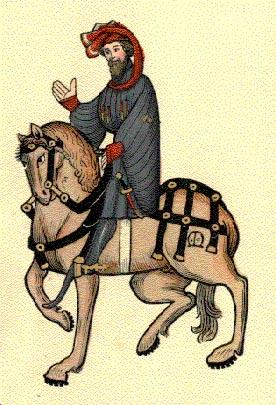Knight on a horse
A knight was part of a long chain of personal relationships that made up a feudal society. This image of the knight comes from an early Chaucer manuscript, the Ellesmere Chaucer Canterbury Tales (ca.1400-1410).
From Huntington Digital Library: "The Ellesmere Chaucer is a beautiful and elaborately decorated manuscript of Geoffrey Chaucer’s Canterbury Tales. Created between 1400 and 1410, it contains what is believed to be a portrait of Chaucer as well as miniature paintings of twenty-two of the fictional pilgrims who tell stories in order to enliven the journey from London to Canterbury. The manuscript is in excellent condition partly because it was undisturbed for about three centuries in the library of Sir Thomas Egerton (later Baron Ellesmere) and his family. The binding dates from 1995, when the manuscript was conserved and rebound to meet modern standards of preservation. For a detailed description including ownership marks and provenance, please see the Huntington Library. Guide to Medieval and Renaissance Manuscripts."

Chaucer, Geoffrey. Canterbury Tales. ca. 1400-1410. From Ellesmere Chaucer Manuscript, housed in the Egerton Family Papers. https://hdl.huntington.org/digital/collection/p15150coll7/id/2385/ (accessed May 17, 2022).
Public Domain
Public Domain is a copyright term that is often used when talking about copyright for creative works. Under U.S. copyright law, individual items that are in the public domain are items that are no longer protected by copyright law. This means that you do not need to request permission to re-use, re-publish or even change a copy of the item. Items enter the public domain under U.S. copyright law for a number of reasons: the original copyright may have expired; the item was created by the U.S. Federal Government or other governmental entity that views the things it creates as in the public domain; the work was never protected by copyright for some other reason related to how it was produced (for example, it was a speech that wasn't written down or recorded); or the work doesn't have enough originality to make it eligible for copyright protection.